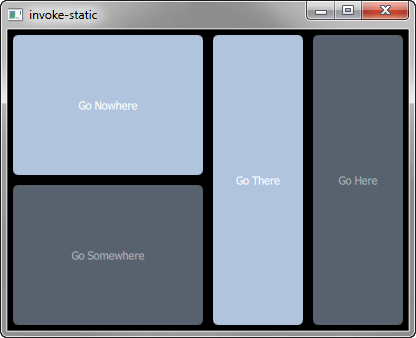援引编译嵌套状态机。

援引
演示如何使用
<invoke>
element with generated nested state-machines, where the SCXML file is compiled to a C++ class. The
<invoke>
element is used to create an instance of an external service.
要运行范例从 Qt Creator ,打开 欢迎 模式,然后选择范例从 范例 。更多信息,拜访 构建和运行范例 .
在 statemachine.scxml , we specify a state machine with the name DirectionsStateMachine 类型 http://www.w3.org/TR/scxml/ to invoke:
<scxml
xmlns="http://www.w3.org/2005/07/scxml"
version="1.0"
name="DirectionsStateMachine"
initial="anyplace"
>
<state id="anyplace">
<transition event="goNowhere" target="nowhere"/>
<transition event="goSomewhere" target="somewhere"/>
<state id="nowhere"/>
<state id="somewhere">
<invoke type="http://www.w3.org/TR/scxml/">
<content>
<scxml name="anywhere" version="1.0">
<state id="here">
<transition event="goThere" target="there"/>
</state>
<state id="there">
<transition event="goHere" target="here"/>
</state>
</scxml>
</content>
</invoke>
</state>
</state>
</scxml>
We link against the Qt SCXML module by adding the following lines to the example's build files.
QT += qml scxml
接着,指定要编译的状态机:
STATECHARTS = statemachine.scxml
find_package(Qt6 REQUIRED COMPONENTS Core Gui Qml Scxml)
target_link_libraries(invoke PRIVATE
Qt6::Core
Qt6::Gui
Qt6::Qml
Qt6::Scxml
)
接着,指定要编译的状态机:
qt6_add_statecharts(invoke
statemachine.scxml
)
The statechart directives
STATECHARTS
or
qt6_add_statecharts
invoke the Qt SCXML Compiler,
qscxmlc
, which is run automatically to generate
statemachine.h
and
statemachine.cpp
, which are then added appropriately as headers and sources for compilation.
The state machine is declared as a QML element as follows:
struct DirectionsStateMachineRegistration { Q_GADGET QML_FOREIGN(DirectionsStateMachine) QML_NAMED_ELEMENT(DirectionsStateMachine) QML_ADDED_IN_VERSION(1, 0) };
We instantiate the generated
DirectionsStateMachine
element in the
MainView.qml
文件,如下:
DirectionsStateMachine {
id: stateMachine
running: true
}